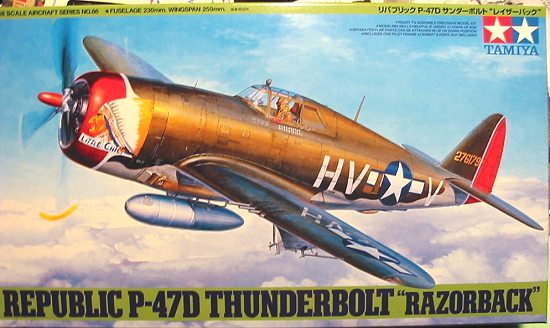
|
KIT: |
Tamiya 1/48 P-47D Thunderbolt (Razorback) |
|
KIT # |
61086 |
|
PRICE: |
$34.95 |
|
DECALS: |
See preview |
|
REVIEWER: |
|
|
NOTES: |

|
HISTORY |
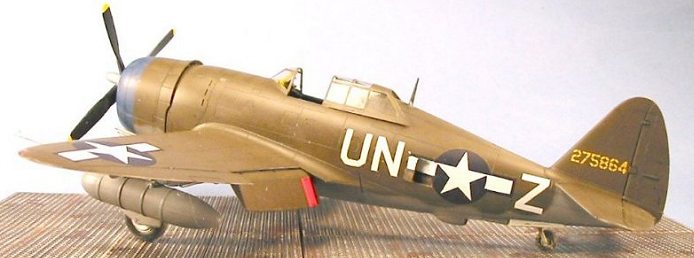
Hub Zemke and "Big Week":
56th Fighter Group
C.O. Hubert "Hub" Zemke was detached from the unit following the near-disastrous
8th Air Force missions over Germany in October 1943 - missions that had seen the
Luftwaffe's fighter force bring the bombing offensive to a halt following the
prohibitive losses of "Black Thursday", the October 14 mission to Schweinfurt
were 60 of 290 bombers were shot down and another 100 were still unserviceable
after return two days later - and returned to the United States in November
1943. His mission and that of the other senior commanders Ira Eaker sent back
to Washington was to convince Hap Arnold and the rest of the USAAF leadership
that the Eighth Air Force bombing offensive should be maintained. Led by
General Curtis LeMay, the representatives made two presentations on the air war
in Washington, and then were dispatched on a tour of stateside bases, briefing
leaders of units assigned to the Eighth that had not yet been sent to England.
Zemke was so good at the presentation that he found his orders changed, with
reassignment to 1st Air Force to train the fighter
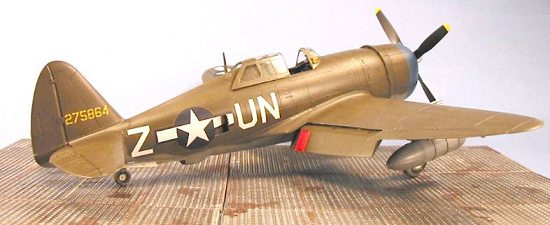 pilots headed for England.
This was not what he wanted; when he found himself unable to get the orders
changed, he essentially went AWOL, and caught a flight to England. As he later
described this in his autobiography, "I figured I had just killed any further
promotion in my career." He was right.
pilots headed for England.
This was not what he wanted; when he found himself unable to get the orders
changed, he essentially went AWOL, and caught a flight to England. As he later
described this in his autobiography, "I figured I had just killed any further
promotion in my career." He was right.
Arriving unannounced in England in mid-January, Zemke was able to convince the new commander of the Eighth, Jimmy Doolittle, that he should return to combat, and his command of the 56th was reinstated. Once back at Halesworth, he took delivery of P-47D-15 s/n 42-75864. Having had his planes previously maintained by the 61st and 62nd Squadrons, he chose to have the 63rd care for the new airplane, which had the then-new Curtiss-Electric paddle-blade prop and was one of the first P-47s in England with the factory-installed wing shackles. On his first mission on January 30th, the group scored its 200th victory since arriving in England a year previously.
At the time, all
P-47s carried theater identification markings of a 24-inch white band on the
nose, a 12-inch stripe on the vertical fin and rudder, and 24-inch stripe around
each horizontal stabilizer. As Zemke later related: "A major difficulty
following a bounce or break in air fighting was reforming a flight or section...
until pulling into a position where the letters on the next P-47 could be
clearly seen, it was often a matter of luck if one was joining the correct
slot... the idea was put forward that an aid to squadron recognition at a
distance would be distinctive colored engine cowlings. There was another angle
to this. From our earliest clashes with the Me-109s and Fw-190s, we were aware
that the various Staffeln were identified by bright nose colors... I obtained
General Kepner's permission to reintroduce the colors we'd used back in the
states - red for 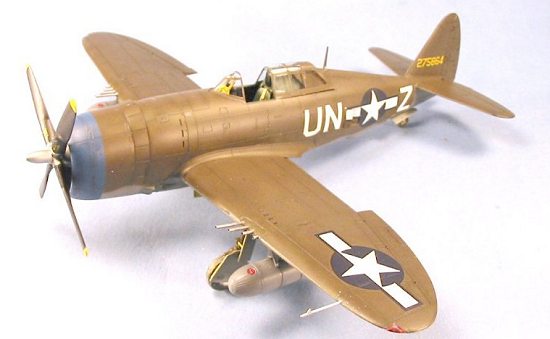 the 61st,
yellow for the 62nd, and blue for the 63rd. In one night all the white paint
was removed from our P-47s noses and the appropriate color applied. We first
flew with this bright paintwork on February 6 and the recognition benefit was
proven." At the same time that the new cowl colors were added, the white ID
stripes on the empennage were removed.
the 61st,
yellow for the 62nd, and blue for the 63rd. In one night all the white paint
was removed from our P-47s noses and the appropriate color applied. We first
flew with this bright paintwork on February 6 and the recognition benefit was
proven." At the same time that the new cowl colors were added, the white ID
stripes on the empennage were removed.
By this time, the group had expanded from 75 to 108 aircraft, and A and B group missions were being flown with formations of 36 aircraft each. Zemke's first mission as group lead since his return was to Frankfurt on February 6. On February 11th, another mission to Frankfurt was flown. Over Walcheren Island, enemy contrails were seen and the 61st Squadron went after the Germans, led by Zemke. After downing one Bf-109, the group's fuel state was such they had to break off the escort. Returning to England at 30,000, Zemke spotted German aircraft on an airfield later identified as Juvincourt, near Reims. 8th Fighter Command had recently permitted groups to strafe enemy airfields during their return from a mission, and he decided to give it a go. With only his flight from the 61st, followed by the 62nd Squadron, Zemke picked out a prominent bunch of trees on the far side of the field and dropped to treetop height for a line-abreast attack. "Fields, trees, houses flashed past the nose of my aircraft and before really recognizing it, the airfield was below. I fired and saw dirt fly short of my selected target. Instantly lifting the nose I ran a stream of bullets into the Me-109. The next moment I was over and past my target. As I pulled up to clear the boundary trees a quick glance in the rear view mirror showed the '109 on fire. My only intention then was to get the hell out the territory because flak was coming up thick and fast. Once back at 10,000 feet, I mused to myself that casual ground attacks of this nature could seriously reduce a fighter pilot's longevity. More knowledge of the disposition and strength of defenses was essential as was the development of special tactics if losses were to be kept low."
On February 20th, the
weather cleared after a week of low clouds and snow, and "Big Week," the Eighth
Air Force's offensive against the German aircraft industry, could begin. That
day, the 56th first used the specially-made 150-gallon metal tanks in the belly
position as both A and B formations flew out to Hanover, a new record for
P-47s. Once there, Gabreski's 61st "A" squadron spotted Me-110s forming below
and hit them unexpectedly. The 61st was credited with 8 destroyed, one probable
and ten damaged, though later records of III/ZG26, the unit hit, revealed that
all ten of the damaged '110s went down. As Zemke noted, "Prior to the change of
policy a few weeks earlier, the Luftwaffe could assemble its
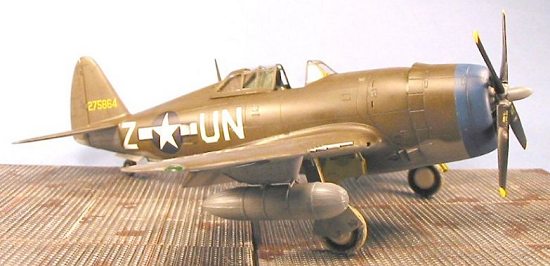 forces at lower altitudes
knowing the Allied escort would remain up above with the bombers. Now they were
finding out the hard way that this no longer held true. Even more
satisfactory, we didn't suffer a single loss."
forces at lower altitudes
knowing the Allied escort would remain up above with the bombers. Now they were
finding out the hard way that this no longer held true. Even more
satisfactory, we didn't suffer a single loss."
On the 21st and 22nd the group went back to the part of west-central Germany they now called "The Happy Hunting Ground," scoring 15 victories on the 22nd, which saw the 61st become the first USAAF squadron in the 8th to score 100 victories as a unit.. "For the third day in a row, we had bested the Luftwaffe without loss."
On February 24th, Zemke was in the lead when he spotted a flight of Fw-190s below. As he dove on one, the German wingman fired at him. "My wingman, Archie Robey, then clobbered him and relieved me of considerable embarrassment." As he closed for the kill, Zemke realized his gunsight was out. He lined up using the post-and-ring back-up, fired and missed. The German dove and Zemke followed. By the time they were almost in the treetops, and as he had fired 300 rounds using the backup sight without effect, Zemke broke off and used the increased climb capability of the paddle prop to break off and try another day. Upon arrival back at Halesworth, his crew chief discovered 20mm holes in Zemke's flaps and elevator. As he put it, "it was the fourth occasion Mrs. Zemke's son little Hubert had returned with evidence that somebody was trying hard to eliminate him."
Two more victories
were scored on the 25th, then the bad weather returned and "Big Week" was over.
"Big Week had provided the 56th Group with its most successful period of
intensive fighting. During February we had credits for the
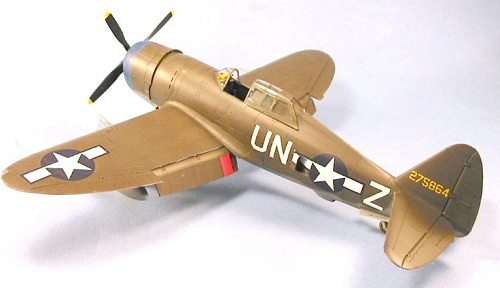 destruction of 72 enemy
aircraft for the loss of only two of our own. An interesting angle on our
success was that over half the battle damage sustained by our P-47s was caused
by parts from enemy aircraft they had destroyed." On February 29, the 56th took
the bombers to Brunswick, and for the first time since they had flown combat in
the ETO, the Luftwaffe made no attempt at interception. It was the beginning of
the end for the Jagdwaffe.
destruction of 72 enemy
aircraft for the loss of only two of our own. An interesting angle on our
success was that over half the battle damage sustained by our P-47s was caused
by parts from enemy aircraft they had destroyed." On February 29, the 56th took
the bombers to Brunswick, and for the first time since they had flown combat in
the ETO, the Luftwaffe made no attempt at interception. It was the beginning of
the end for the Jagdwaffe.
During the March 6th mission to Berlin, Zemke shot down a Fw-190, using the water injection system on his Thunderbolt for the first time to catch the enemy fighter as it banked away from an attack on a B-17. Banking away to avoid collision after the killing burst, Zemke caught a Bf-109, which he dispatched with a 20-degree deflection shot.
On March 16, 1944, Zemke's Thunderbolt, 42-75864 was destroyed by fire on the ground at Halesworth in a refueling accident.
|
THE KIT |
For a look at what's in the box, see the preview.
|
CONSTRUCTION |
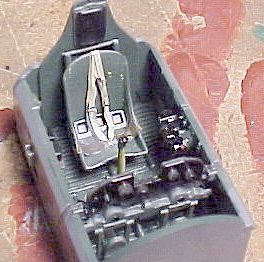 Hey, it's a Tamiya kit.
Unless you are too illiterate to read the instructions, and too ham-fisted to
touch the parts without breaking them, it is impossible for you to not "get it
right" by following the instructions.
Hey, it's a Tamiya kit.
Unless you are too illiterate to read the instructions, and too ham-fisted to
touch the parts without breaking them, it is impossible for you to not "get it
right" by following the instructions.
First, I painted all
the interior parts for the cockpit and the engine area, wheel wells, etc., and
set those aside to dry for the day; my only departure from the kit instructions
was to paint the main 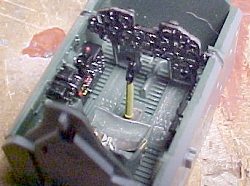 gear
legs Olive Drab, since that is the callout in the Profile Publication "P-47
Camouflage and Markings," which quotes from the original painting instructions.
gear
legs Olive Drab, since that is the callout in the Profile Publication "P-47
Camouflage and Markings," which quotes from the original painting instructions.
That evening, I sat down and followed the instructions, and had the kit assembled in about 2 hours of enjoyable work. There are no problems to worry about, given that the production design of the kit is as good as the Corsair and the Wildcat - what more needs be said? I left off the flaps and landing gear for attachment after further painting.
|
PAINT & DECALS |
Painting:
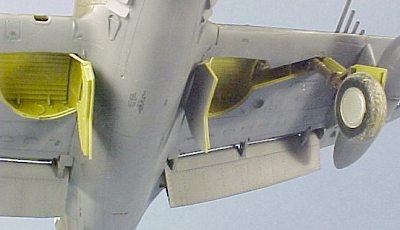 I had decided to do Hub
Zemke's P-47D-15 which he flew from January 25 - March 16, 1944. This was a
factory-fresh airplane, that was flown on a total of 14 missions before it was
destroyed by fire in a fueling accident. The photos of 42-75864 in Zemke's
autobiography show a very clean airplane with no weathering. Given that its
operational life was a period of bad weather, it would only have been exposed to
sunlight at high altitude, so I decided to give it "ultra-violet fading" in the
Olive Drab upper surfaces. This is the kind of fading one should apply to any
airplane flown in the European Theater, where most days were cloudy or overcast,
and airplanes were only exposed to direct sunlight at high altitude - and those
were perhaps two or three days of a given week, given the weather restrictions
on operations. (Go back and look at the 56th's February record - they only
flew 9 missions in the whole month.)
I had decided to do Hub
Zemke's P-47D-15 which he flew from January 25 - March 16, 1944. This was a
factory-fresh airplane, that was flown on a total of 14 missions before it was
destroyed by fire in a fueling accident. The photos of 42-75864 in Zemke's
autobiography show a very clean airplane with no weathering. Given that its
operational life was a period of bad weather, it would only have been exposed to
sunlight at high altitude, so I decided to give it "ultra-violet fading" in the
Olive Drab upper surfaces. This is the kind of fading one should apply to any
airplane flown in the European Theater, where most days were cloudy or overcast,
and airplanes were only exposed to direct sunlight at high altitude - and those
were perhaps two or three days of a given week, given the weather restrictions
on operations. (Go back and look at the 56th's February record - they only
flew 9 missions in the whole month.)
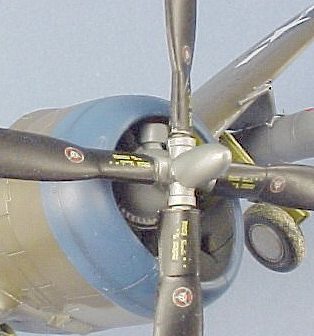 Once I pre-shaded the
entire model, I painted the nose a light-medium blue closely approximate to
pre-war Air Corps Blue, which was mixed from Tamiya "Blue" and "Sky Blue" till
it looked "close enough." When dry, I masked it off and painted the lower
surfaces with Tamiya "Neutral Grey." I added in a bit of "Sky Grey" and went
back over the area to give it multi-hued fading. I finished that off by using
straight "Neutral Grey" to over-paint the area on the lower horizontal
stabilizer and elevator where the white ID stripes would have been (remember,
Zemke says those came off the same night the colorful nose was painted).
Once I pre-shaded the
entire model, I painted the nose a light-medium blue closely approximate to
pre-war Air Corps Blue, which was mixed from Tamiya "Blue" and "Sky Blue" till
it looked "close enough." When dry, I masked it off and painted the lower
surfaces with Tamiya "Neutral Grey." I added in a bit of "Sky Grey" and went
back over the area to give it multi-hued fading. I finished that off by using
straight "Neutral Grey" to over-paint the area on the lower horizontal
stabilizer and elevator where the white ID stripes would have been (remember,
Zemke says those came off the same night the colorful nose was painted).
For the Olive Drab
upper surfaces, I started with Gunze-Sanyo "Olive Drab (2)", which says it's for
"U.S. Army tank". It's a darker olive drab, closer to the original OD 41
shade. I freehanded the wavy-line color break between upper and lower
surfaces. When this was finished, I used Gunze-Sanyo "Olive Drab (1)" which is
a lighter, browner shade, to go over panels and fade them. When that was done,
I took some Gunze-Sanyo "Violet" and mixed it in with the "Olive Drab (1)" which
gave a strange brownish color with violet overtones. I made sure this was
thinned 50-50, then went over the upper surfaces of the wings and horizontal
stabilizer, fading them in various areas, much like what one sees in the color
photos in Jeff Ethell's "World War II In Color" series. This was also done to
the upper areas of the 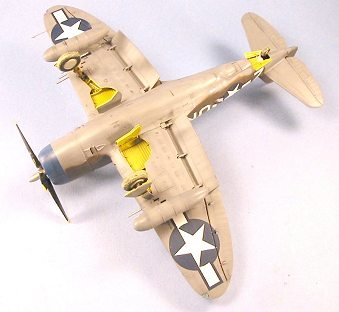 fuselage,
panel by panel. I finished off with some "Olive Drab (2)" oversprayed where the
ID bands would have been on the horizontal stabilizers and vertical fin. All
of this is very subtle and only visible under direct incandescent lighting.
Remember, this was a new, well cared-for airplane flown by the Group Commander,
whose painted surface was most likely additionally protected by automotive
polish applied by the ground crew.
fuselage,
panel by panel. I finished off with some "Olive Drab (2)" oversprayed where the
ID bands would have been on the horizontal stabilizers and vertical fin. All
of this is very subtle and only visible under direct incandescent lighting.
Remember, this was a new, well cared-for airplane flown by the Group Commander,
whose painted surface was most likely additionally protected by automotive
polish applied by the ground crew.
Once all this was done, I futured the model prior to applying the decals.
Decals:
I used the Three Guys Replicas "Zemke" sheet, which has all of the P-47s, the P-38 and the P-51D flown by Hub Zemke during the war. The sheet is very well-researched, and all the information is correct. Though the instructions say the airplane carried oversize US national insignia on both lower wings, only one is provided. I got the under wing decals out of the decal dungeon. The TGR decals themselves are very well-printed by Micro-Scale and go down without problems. I used the kit stenciling decals, which also proved no problem.
|
FINAL ASSEMBLY |
I used some Tamiya "Smoke" very, very sparingly to provide a bit of exhaust and oil staining right aft of the cowling. This was an airplane that was cleaned up after each mission. The photos of the airplane show no "dinging," so I did none to the model. I gave the model two coats of Dullcote, then a light coat of Testor's Metalizer Sealer, to give it a sheen as if it has been waxed - which the real one was. Assembly of the landing gear and attachment of the prop and drop tanks provided no problems.
Glaring Glitches:
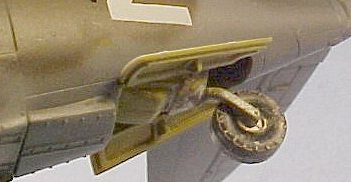 As I was working on
assembling the landing gear, I suddenly realized the tail wheel didn't look
right. It took a few minutes studying the parts and studying the instruction
sheet to realize that Tamiya managed to mold the tail wheel leg so that it aims
forward rather than aft. I had to cut mine and reposition it to get it right.
As I was working on
assembling the landing gear, I suddenly realized the tail wheel didn't look
right. It took a few minutes studying the parts and studying the instruction
sheet to realize that Tamiya managed to mold the tail wheel leg so that it aims
forward rather than aft. I had to cut mine and reposition it to get it right.
The other "glitch" was self-created: the centerline sway braces are very delicate. Before I had the gear on, but after I had installed these (and noticed their delicacy), I set the model down upright (i.e., right on the braces) and they broke. One was swallowed by the carpet monster. The result was I puttied over the bracing and made a "smooth" belly, and used the 108-gallon paper tanks (I had planned to use the "flat" tank, since the 56th didn't get the sway braces to stop vibrating on wing tanks till mid-March, and used the locally-made 150-gallon "flat tank" on ops in February 1944.) So, be careful if you plan to use a centerline store.
|
CONCLUSIONS |
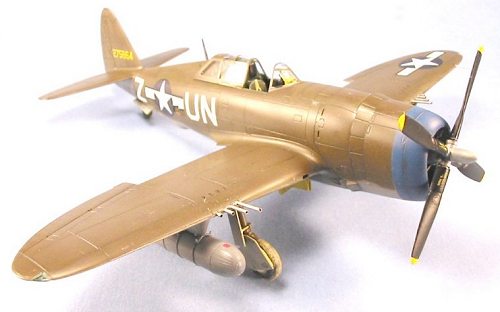 With the Tamiya P-51D
Mustang, you really need to get a resin cockpit, and you have to "fiddle" with
the landing gear of the Wildcat; you need a lot of aftermarket resin to correct
any of the Fw-190s, and the Bf-109E is definitely second-rate compared with the
same kit from Hasegawa. This P-47 kit needs no aftermarket goodies, and the
only "fiddling" during assembly is fixing the tail wheel. It looks accurate
when compared to the drawings I have in my research collection, and looks
right sitting there when compared with photographs of the real ones. To my
mind, it's the best kit Tamiya has done since the Swordfish. (OK, OK... the
Do-335 and the Gekkos are well-designed models; they just never "grabbed me,"
not like this kit does.) If you are looking for the "definitive" razorback Jug,
here it is. I'm sure I'll do others. For what is included in the box, this kit
is a bargain.
With the Tamiya P-51D
Mustang, you really need to get a resin cockpit, and you have to "fiddle" with
the landing gear of the Wildcat; you need a lot of aftermarket resin to correct
any of the Fw-190s, and the Bf-109E is definitely second-rate compared with the
same kit from Hasegawa. This P-47 kit needs no aftermarket goodies, and the
only "fiddling" during assembly is fixing the tail wheel. It looks accurate
when compared to the drawings I have in my research collection, and looks
right sitting there when compared with photographs of the real ones. To my
mind, it's the best kit Tamiya has done since the Swordfish. (OK, OK... the
Do-335 and the Gekkos are well-designed models; they just never "grabbed me,"
not like this kit does.) If you are looking for the "definitive" razorback Jug,
here it is. I'm sure I'll do others. For what is included in the box, this kit
is a bargain.
Thanks to HobbyLink Japan for providing the review copy.
.If you would like your product reviewed fairly and quickly by a site that has well over 150,000 visitors a month, please contact me or see other details in the Note to Contributors.